2.Prediction of environmental variation by coastal conservation facilities
Factors which are considered to affect ecosystems due to the installation of coastal conservation facilities include the emergence of orienting landmarks, bases and void spaces, accumulation of substances, deposits which become sandy and muddy, scouring of seabed, and formation of shallow areas. In particular, installed facilities alter the surroundings by affecting the waves and currents. Detached breakwaters, artificial reefs, jetties, and headland all have an impact on the waves and nearshore currents, which eventually lead to long-term variations in landform. As changes in waves and nearshore currents are known to affect the distribution of plankton and the behavior of sea turtles coming ashore, such influences must be examined prior to installing coastal conservation facilities.
When calculating waves and nearshore currents, representative waves during the period when the target species in the target coastal areas are closely related to waves and currents in their life history should be used. For instance, the annual maximum waves are given as the external force when disturbance due to tidal waves is the predominant factor, and average waves when currents at normal times are the predominant factor. When setting waves, it is essential to refer to the data of oceanographic phenomena measured by observatories nearby and to consider conformance with the actual state of waves and currents in the target coastal areas.
The figures below show the results of nearshore current calculations before and after installing detached breakwaters. The arrows represent the velocity of nearshore currents, whereas the shading denotes the water depth. Assuming normal time in summer, waves of significant wave height of 0.8 m, significant wave period of 7.0 s, and wave direction, E, were given. Installation of the detached breakwaters speeded up the currents heading toward the deep part of the opening in the detached breakwaters, but the increase in the velocity was no more than around 10 cm/s.
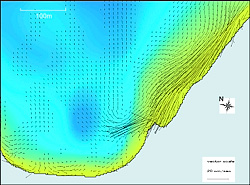 |
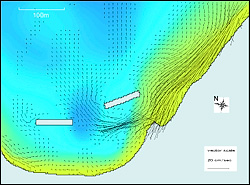 |
|
Change in nearshore currents due to detached breakwater installation (left figure: before installation, right figure: after installation)
|
The figures below show an example of the results of nearshore current calculations before and after installing artificial reefs. As with the case of the detached breakwaters, waves during normal time in summer were assumed. Rip currents and onshore currents appeared alternately at intervals of around 130 m shoreward before the installation, but the onshore currents and the rip currents were fixed at the shoreward side and at the openings of the artificial reefs after the installation.
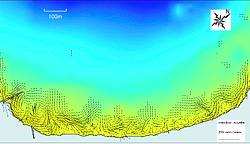 |
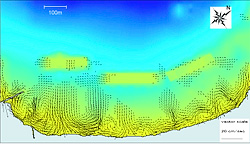 |
|
Change in nearshore currents due to artificial reef installation (left figure: before installation, right figure: after installation)
|
The figures below show an example of nearshore currents before and after installing a jetty. Likewise, waves during normal time in summer were assumed. Due to the installation of the jetty, the current slowed down at the upstream side of the jetty and speeded up at the downstream side; however, the changes were not conspicuous.
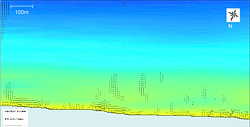 |
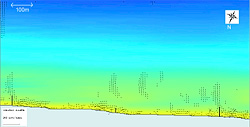 |
|
Change in nearshore currents due to jetty installation (left figure: before installation, right figure: after installation)
|
